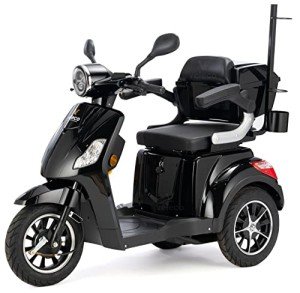Buying Mobility Scooter: The Good, The Bad, And The Ugly

A Comprehensive Guide to Buying a Mobility Scooter
Mobility scooters have actually ended up being an essential tool for many people wanting to boost their independence and mobility. With a large array of models and features readily available, picking the best mobility scooter can be intimidating. This short article provides a useful guide to assist consumers browse their choices, examine their needs, and make a notified purchase.
Comprehending Mobility Scooters
Mobility scooters are electric vehicles created for people who experience mobility difficulties. They are especially useful for seniors, those with specials needs, or individuals recuperating from injuries. Mobility scooters can differ commonly in regards to design, functions, and rates.
Kinds Of Mobility Scooters
Before embarking on a purchase, it's necessary to understand the different types of mobility scooters readily available:
Three-Wheel Scooters:
- Generally more maneuverable in tight spaces
- Lightweight and portable
- Suitable for indoor usage
Four-Wheel Scooters:
- Offer higher stability and balance
- Ideal for outside usage over numerous terrains
- Usually have a longer battery life
Foldable/Portable Scooters:
- Designed to be easily transported and kept
- Can often suit the trunk of an automobile
- Perfect for those who take a trip frequently
Sturdy Scooters:
- Built to accommodate bigger individuals
- Typically come with more robust features for outside use
- Normally geared up with bigger batteries for prolonged variety
Aspects to Consider When Buying a Mobility Scooter
1. Weight Capacity
Select a mobility scooter that can support the user's weight. The majority of scooters have a weight limitation ranging from 250 to 500 pounds. It is important to make sure that the scooter can accommodate the user easily.
2. Range and Battery Life
The variety is how far the mobility scooter can take a trip on a single charge. Normal varieties vary in between 10 to 30 miles. Think about the user's day-to-day activities and select a scooter with a suitable range.
3. Scooter Dimensions
Consider the size of the scooter, including its weight and dimensions. A more compact scooter might be perfect for narrow hallways and tight spaces, while bigger designs provide additional stability and comfort.
4. Surface Capability
Examine where the scooter will mostly be utilized. If the user plans to travel primarily on pavement, a lightweight model might be sufficient. However, if the user requires to pass through gravel or unequal surface areas, consider a four-wheel scooter constructed for off-road usage.
Leading Features to Look For
Convenience
- Adjustable Seats: Look for scooters with cushioned and height-adjustable seats to guarantee comfort throughout travel.
- Armrests: These enhance safety and support while navigating.
Security and Visibility
- Headlights and Taillights: Essential for nighttime usage.
- Turn Signals and Reflectors: Improve exposure and security while on the road.
User-Friendly Controls
- Joystick or Drive Controls: These should be user-friendly and easy to manipulate.
- Easy-to-Read Displays: A control panel that reveals battery life, speed, and range can improve the user experience.
Additional Features
- Storage Compartments: These offer added benefit for carrying individual items while on the go.
- Weather Protection: Consider designs with rain covers or windscreens if utilized in variable climate condition.
Expense Considerations
When budgeting for a mobility scooter, prices can vary anywhere from ₤ 500 to over ₤ 5,000 depending on the design, features, and brand name. Extra costs might consist of:
- Extended Warranty: Protects versus flaws and can conserve money in the long run.
- Devices: Optional functions, such as updated seats, lights, or storage solutions.
| Function | Expense Range |
|---|---|
| Fundamental Models | ₤ 500 - ₤ 1,500 |
| Mid-Range Models | ₤ 1,500 - ₤ 3,000 |
| High-End Models | ₤ 3,000 - ₤ 5,000 |
Funding Options
Many merchants provide funding strategies, and some local federal government efforts may offer grants or support for those in requirement. Examine prospective monetary assistance with neighborhood resources or mobility service companies.
Frequently asked questions about Buying a Mobility Scooter
What is the distinction between a mobility scooter and a wheelchair?
Mobility scooters are motorized and permit users to navigate individually, while wheelchairs might need physical help or manual operation.
How do I maintain a mobility scooter?
Regular upkeep includes examining battery life, cleaning the scooter, and examining tires and brakes. Constantly describe the user manual for specific standards.
Can mobility scooters be utilized inside your home?
Yes, numerous designs are developed for both indoor and outdoor usage. Nevertheless, three-wheel scooters tend to be better matched for indoor navigation due to their tighter turning radius.
Are mobility scooters covered by insurance coverage?
Some insurance prepares cover a part of the costs for mobility scooters if they are deemed medically required. Contact your company for specific information.
How quick can a mobility scooter go?
Most mobility scooters have an optimal speed varying from 4 to 8 mph. However, the suitable pace might vary depending upon local guidelines.
Getting a mobility scooter can substantially enhance one's self-reliance and quality of life. By understanding the types, functions, and costs connected with mobility scooters, prospective purchasers can make knowledgeable decisions that fit their requirements and choices. More inspiring ideas and extensive research are crucial to making sure complete satisfaction with this crucial investment.

